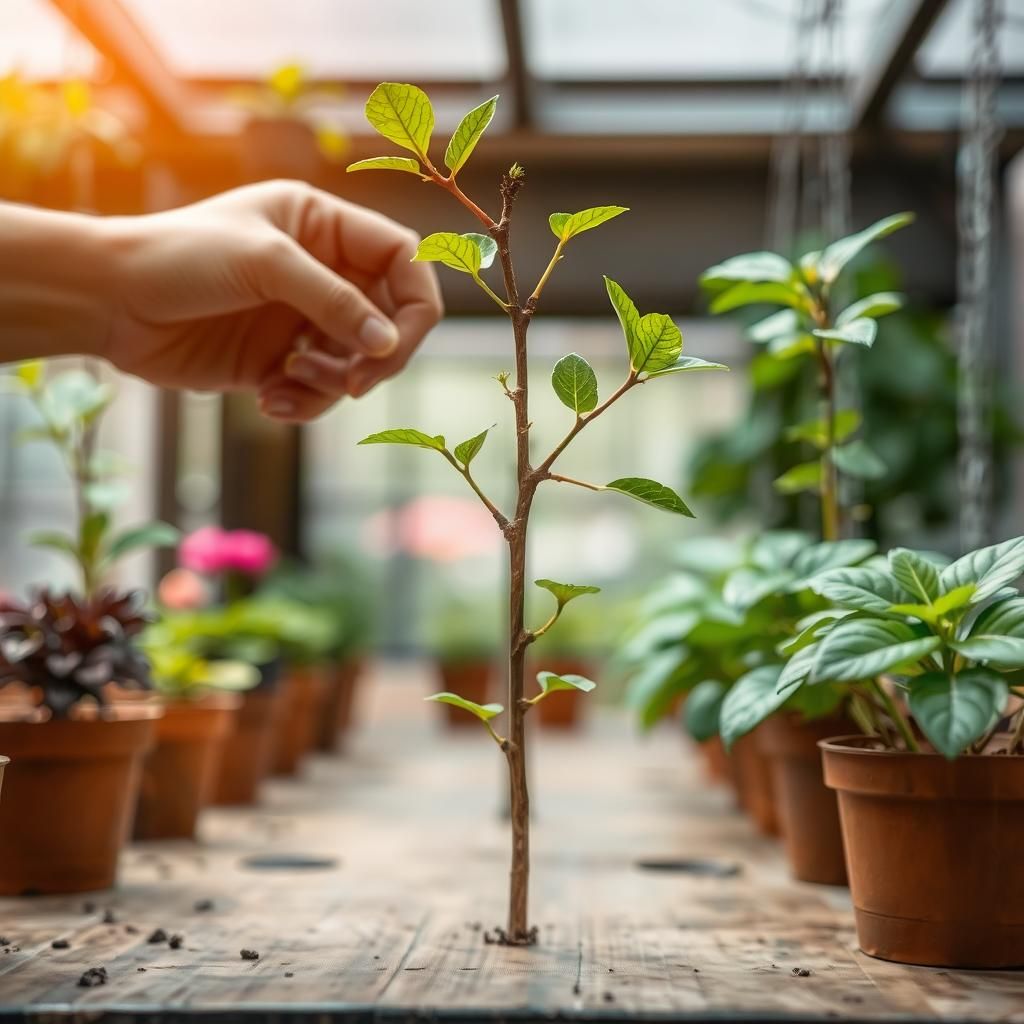What is the air pruning method? Discover its Benefits for Healthy Plant Growth

Air pruning is an innovative gardening technique that has gained popularity among plant enthusiasts and horticulturists alike. This process involves the exposure of plant roots to air, promoting healthier growth and development by preventing them from becoming root-bound. As roots reach the edge of their containers, they encounter air, which triggers a natural response: the growth of new root tips. This article delves into the air pruning method, exploring its key benefits for plant health, including improved nutrient absorption, enhanced water retention, and overall vigorous growth. Discover how air pruning can revolutionize your gardening practices and lead to thriving plants.
What is the Air Pruning Method?
The air pruning method is an innovative technique used in horticulture to enhance root development in plants. This method involves exposing the roots to air as they grow, which prevents them from becoming root-bound and helps stimulate lateral root growth. Typically, this process is achieved using specialized containers that allow for air circulation at the root zone. Once the roots reach the edges of the pot, the exposure to air causes the growing tips to die back, encouraging the plant to develop more fibrous roots. This results in a healthier plant with a robust root system, ultimately improving its ability to absorb nutrients and water from the soil.
How Does Air Pruning Work?
Air pruning works by allowing roots to grow until they reach the edge of their planting container. At this point, when the roots encounter air, they stop growing and are effectively pruned. This process promotes the development of new lateral roots closer to the center of the container rather than allowing them to spiral around the edge. The continuous pruning of the tips encourages a denser and more fibrous root structure, which is essential for the overall health of the plant.
Benefits of Air Pruning
The benefits of air pruning are numerous. Firstly, it reduces the likelihood of root-bound conditions, which can stunt plant growth and lead to health issues. Additionally, this method improves nutrient and water absorption as a more extensive root system can access more soil area. Plants grown with air pruning typically exhibit increased vigor, better resilience against environmental stressors, and enhanced growth rates. This technique is especially advantageous in container gardening and large-scale horticultural operations.
Air Pruning Containers
To effectively utilize the air pruning method, specialized containers are designed with ventilation features. These containers often have perforations or breathable materials that allow air to flow freely into the root zone. Examples include fabric pots, air pruning pots, and DIY containers made from perforated plastic. The design of these containers maximizes exposure to the air while maintaining a proper balance of moisture, preventing the substrate from drying out too quickly while encouraging root health.
See also:
Applications of Air Pruning
Air pruning is applicable in various horticultural practices, including nursery production, home gardening, and agricultural systems. It is particularly beneficial for growing young plants, such as trees and shrubs, as it helps them develop strong root systems before being transplanted into the ground. Farmers and growers often adopt this method to improve yield and quality of crops, leading to more sustainable practices while enhancing biodiversity in agricultural systems.
Comparing Air Pruning with Traditional Methods
When compared to traditional growing methods, air pruning offers significant advantages. In conventional containers, roots can become root-bound, leading to a myriad of issues such as poor growth and susceptibility to diseases. Conversely, air pruning allows for continuous root development and a healthier plant overall. Although both methods can be effective, air pruning is often preferred by those seeking to maximize plant health, improve growth efficiency, and reduce the need for chemical interventions in the garden.
| Aspect | Air Pruning | Traditional Methods |
|---|---|---|
| Root Development | Encourages fibrous root structure | Can lead to root-binding |
| Plant Health | Overall healthier plants | More prone to stress and diseases |
| Container Design | Specialized breathable containers | Standard containers |
| Water and Nutrient Absorption | Improved due to enhanced root system | Often limited by root binding |
| Growth Rate | Typically faster and more vigorous | Often slower due to stress factors |
Understanding the Science Behind Air Pruning
The air pruning method is a cultivation technique that promotes healthy root development by exposing plant roots to air instead of allowing them to become root-bound in traditional containers. When roots reach the edges of a pot and are exposed to air, they self-prune, effectively stopping their growth and initiating the development of new lateral roots. This leads to a more vigorous root system, improving the plant's ability to absorb nutrients and water, ultimately resulting in better overall plant health and growth.
How Does Air Pruning Work?
Air pruning operates on the principle that when roots reach the edge of a container, they encounter air, which causes the root tips to dry out and die off. This process prevents roots from circling within the pot, encouraging the plant to generate new roots that proliferate in search of moisture and nutrients. As a result, the plant develops a denser and healthier root structure, which enhances its capacity for absorption and stability.
Benefits of Air Pruning for Plant Growth
One of the primary benefits of air pruning is the promotion of a robust root system that can significantly improve the plant's growth rate and nutrient uptake. By preventing the roots from becoming pot-bound, plants can utilize water and nutrients more efficiently. This leads to increased yield and overall plant vitality, which is especially advantageous for growers aiming for high-quality produce.
See also:
Air Pruning Techniques and Tools
To implement air pruning effectively, various tools and containers are utilized, such as air pruning pots, which feature slotted designs to allow for optimal air exposure. Additionally, fabric pots are often used as they encourage air circulation around the roots. These methods can be adapted for both home gardening and professional agriculture, ensuring that the plants receive the necessary airflow to stimulate optimal growth.
Comparison with Traditional Container Gardening
In contrast to traditional container gardening, where roots may become circulated or compressed, air pruning offers a more effective solution for root health. The restrictive environment of standard pots often leads to waterlogging and nutrient deficiencies, while air pruning minimizes these risks, ensuring that roots can thrive. This ultimately leads to fewer transplant shock conditions when moving plants to larger spaces or the ground.
Challenges and Considerations for Air Pruning
While air pruning has considerable benefits, growers should also consider potential challenges such as moisture management. Since air pruning relies on adequate air exposure, it is crucial to monitor the soil moisture levels consistently to prevent drying out and ensure plants receive sufficient water. Understanding the specific needs of different plant species can help mitigate these challenges, leading to successful air pruning practices.
Questions from Our Readers
What is the air pruning method?
The air pruning method is a technique used in horticulture that involves exposing the roots of plants to air or less humid conditions, which promotes healthy root development. When roots reach the air, they are effectively pruned, encouraging the plant to grow more lateral roots and ultimately leading to a stronger and more robust root system.
How does air pruning benefit plants?
Air pruning benefits plants by enhancing the root structure and preventing root circling, a common problem in traditional pots. When roots are pruned by air exposure, they grow more evenly and densely, which improves the plant’s ability to absorb nutrients and water, leading to healthier and more vigorous growth.
See also:
What types of containers are used for air pruning?
Containers designed for air pruning typically have ventilation holes or are made from breathable materials that allow air to circulate around the roots. Common options include fabric pots, air pruning pots, and specially designed containers that facilitate root exposure to air while retaining moisture and supporting plant growth.
Can air pruning be used for all types of plants?
While air pruning is particularly effective for many plants, especially vegetables, flowers, and shrubs, not all plants respond equally well. It is most beneficial for species that prefer well-aerated soil and can tolerate root exposure, but it's always advisable to consider the specific requirements of each plant type before employing this method.

If you want to read more articles like What is the air pruning method? Discover its Benefits for Healthy Plant Growth, we recommend you check out our Planter category.
Leave a Reply
Related Articles